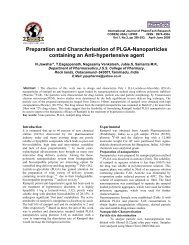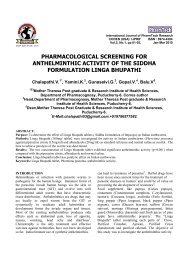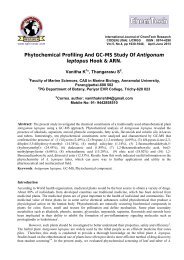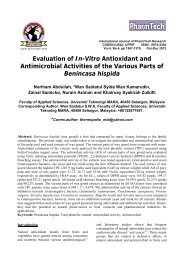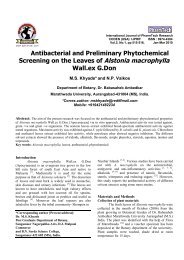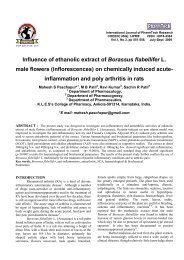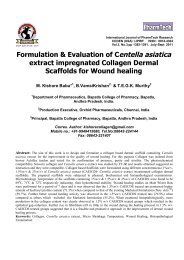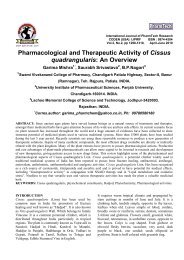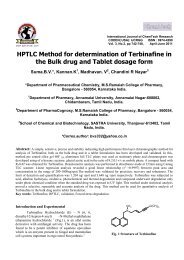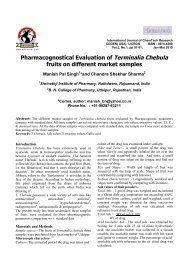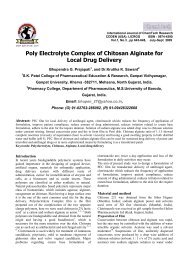Antidiabetic activity of ethanol extract of Colocasia esculenta leaves ...
Antidiabetic activity of ethanol extract of Colocasia esculenta leaves ...
Antidiabetic activity of ethanol extract of Colocasia esculenta leaves ...
Create successful ePaper yourself
Turn your PDF publications into a flip-book with our unique Google optimized e-Paper software.
Deshmukh T. A. et al /Int.J. PharmTech Res.2010,2(2) 1247<br />
University, Nagpur. The voucher specimen (No. 9413)<br />
was deposited at that institute.<br />
Preparation <strong>of</strong> EECE <strong>extract</strong>:<br />
The <strong>leaves</strong> <strong>of</strong> <strong>Colocasia</strong> <strong>esculenta</strong> were shade dried<br />
and powdered in a grinder. The air-dried powder was<br />
subjected to hot continuous <strong>extract</strong>ion with <strong>ethanol</strong> in<br />
a soxhlet <strong>extract</strong>or. The <strong>extract</strong> was concentrated under<br />
reduced pressure using rotary evaporator and the<br />
residue was dried in desiccators over anhydrous<br />
calcium chloride. The percentage yield <strong>of</strong> <strong>ethanol</strong><br />
<strong>extract</strong> was 3.71 % w/w.<br />
Chemicals:<br />
Glucometer (Acucheck-Sensor) was purchased from<br />
Roche Diagnostics, Mumbai, India Metformin was<br />
obtained as gift sample from IPCA Laboratories,<br />
Mumbai, India. Alloxan monohydrate was purchased<br />
from Sigma, USA. Ethanol was purchased from<br />
Ranbaxy Fine Chemicals Ltd., New Delhi, India..<br />
Qualitative chemical tests:<br />
Ethanol <strong>extract</strong> was tested to know the different<br />
constituents present in it by the standard procedures.<br />
10, 11<br />
The <strong>extract</strong> was tested for alkaloids, saponins,<br />
flavonoids, 12 and tannins, 13<br />
Animals:<br />
All the experiments on animal were conducted<br />
according to protocols that were approved by the<br />
Institutional Animal Ethics Committee (IAEC) <strong>of</strong><br />
Hon’ble Madhukarrao Chaudhari College <strong>of</strong><br />
Pharmacy, Faizpur, India. Wister albino rats (150–200<br />
g) <strong>of</strong> either sex were purchased from Calcutta Fish<br />
Aquarium, Indore, India. They were maintained at a<br />
temperature <strong>of</strong> 25 ± 5 0 C and relative humidity <strong>of</strong> 50%<br />
to 55%. The animals were allowed free access to food<br />
pellets (Amrut Feeds, Pune, India) and water<br />
throughout the study. Acute toxicity study was carried<br />
out using albino mice.<br />
Acute toxicity study:<br />
Albino mice <strong>of</strong> either sex weighing between 20-30 g<br />
were used. The animals were fasted over night. Acute<br />
toxicity study was performed according to OECD<br />
guidelines; method followed is according to number<br />
420. It was found that tolerated dose was higher than<br />
5,000 mg/kg body weight. 14<br />
Alloxan-induced diabetes:<br />
The albino rats weighing 150-200 g <strong>of</strong> either sex were<br />
allowed to fast for 24 hours prior to experimentation<br />
and rendered diabetic by a single dose <strong>of</strong><br />
intraperitoneal injection <strong>of</strong> alloxan 120 mg/kg body<br />
weight. 15 After 18 hours <strong>of</strong> injection <strong>of</strong> alloxan,<br />
diabetes was confirmed by testing blood sugar level<br />
more than 200 mg/dl were selected for the further<br />
study. Animals were maintained for four days in<br />
diabetic condition for well establishment <strong>of</strong> diabetes.<br />
They were divided into five groups. Group I: untreated<br />
but diabetes-induced animals served as a negative<br />
control; Group II: diabetes-induced animals and<br />
treated with standard drug metformin 450 mg/kg body<br />
wt./day orally; Group III: diabetic animals and treated<br />
with <strong>ethanol</strong> <strong>extract</strong> (100 mg/kg); Group IV: diabetic<br />
animals and treated with <strong>ethanol</strong> <strong>extract</strong> (200 mg/kg);<br />
Group V: diabetic animals and treated with <strong>ethanol</strong><br />
<strong>extract</strong> (400 mg/kg). The <strong>ethanol</strong> <strong>extract</strong> was given<br />
orally.<br />
The acute study involved estimation <strong>of</strong> blood glucose<br />
levels at 0, 2, 4, 6 and 24 hour after EECE and<br />
metformin administration. The animals had free access<br />
to feed and water after 6 h. The subacute study<br />
involved repeated administration <strong>of</strong> EECE and<br />
metformin for 14 days (once a day) at a prefixed times<br />
and blood glucose levels were estimated in samples<br />
withdrawn after 2 h on day 7 and 14. 16 The animals<br />
had free access to feed and water during this period.<br />
Blood samples from the experimental rats were<br />
collected by the tail using pricking lancet. The<br />
collected blood samples were analyzed for blood<br />
glucose levels by the glucometer using strip technique<br />
and blood glucose levels were expressed in mg/dl. The<br />
data was represented as mean blood glucose level and<br />
standard error <strong>of</strong> mean (SEM).<br />
During the study period <strong>of</strong> 14 days the rats were<br />
weighed daily and their body weights were recorded.<br />
From this data, mean change in body weight and SEM<br />
were calculated and tabulated.<br />
Statistical analysis:<br />
Data were expressed as mean ± SEM and statistical<br />
analysis was carried out by one-way ANOVA with a<br />
post hoc Tukey's test performed using GraphPad InStat<br />
version 3.00 for Windows 95, GraphPad S<strong>of</strong>tware, San<br />
Diego California USA, www.graphpad.com. p



